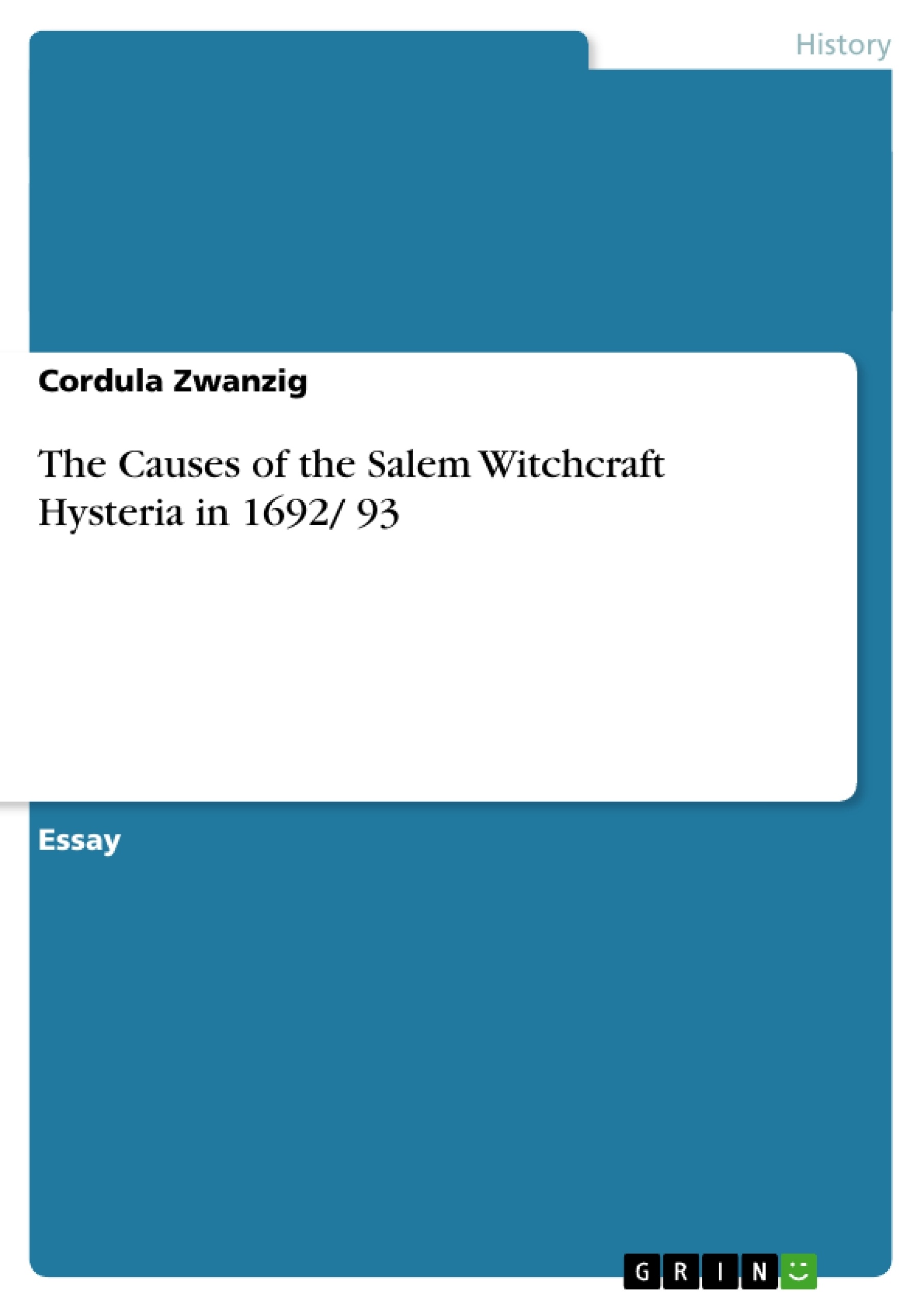There is no reason for the Salem Witch Craft Trials – at least no instantly understandable one from our modern point of view. The majority of Western civilisation, firstly, would certainly deny magic had any impact on their life and, secondly, would not tolerate such violence as a normal measure of justice. Thus, in order to understand the causes of the events we must try to walk in the villagers’ shoes, explore the historical background. In the seventeenth century, people were still confronted with much more basic threats than just the modern possible lack of self-actualisation.
There is no reason for the Salem Witch Craft Trials – at least no instantly understandable one from our modern point of view. The majority of Western civilisation, firstly, would certainly deny magic had any impact on their life and, secondly, would not tolerate such violence as a normal measure of justice. Thus, in order to understand the causes of the events we must try to walk in the villagers’ shoes, explore the historical background. In the seventeenth century, people were still confronted with much more basic threats than just the modern possible lack of self-actualisation. While Steven Pinker recently demonstrated the continuing decline in violence over the centuries statistically, John Proctor and many of their fellow victims prove the brutal reality in 1692/ 93.[1]
Moreover a much stronger belief system must be assumed in which witchcraft was perceived as absolutely likely. Consequently, general reasons which were widely discussed in research so far will be mentioned alongside the impact of certain persons such as Cotton Mather and other ministers or the afflicted girls. Although Demos’ case studies highlight the different causes for witch persecutions between Pre-Salem and Salem witchcraft trials in Entertaining Satan. (Oxford 2004) we only want to focus on 1692/ 93. Finally, the unusual size of the outbreak of witchcraft accusations becomes more understandable and we will see that religious zeal was rather the cloak for plain fear.[2]
Although religion cannot be regarded as the single reason for the turmoil the combination of religious beliefs at that time, the legal system, and widespread superstition produced a fertile basis for escalation. Instead of an Anglican-Protestant a rather Puritan mindset must be assumed for the majority of settlers in Massachusetts.[3] Even though the American witchcraft beliefs originate from European conceptions, i.e. the respective readings of the Bible, the convictions differ from the Old World’s. Firstly, we hardly ever find accounts of sexual possessions.[4] Secondly, ‘[the] idea of the witch as a female challenger of the religious system never permeated colonial consciousness, and in itself never resulted in witchcraft convictions’, as Karlsen points out.[5] Even less common are convictions as a result of different faith or culture: In fact, the washerwoman Glover is one of the very few examples.[6]
Driven by the constant preoccupation of the collapse of this highly conservative and fragile society, the precepts of the churches imposed all kinds of everyday life rules in order to restrict amusements: religious doctrine schooling was considered morally worthwhile as opposed to singing profane songs or playing with dolls.[7] Concretely, in the winter of 1689, Samuel Parris and his followers formed a group aiming at religious restoration because they already reckoned to observe a declining devoutness.[8] The strength of religious faith might be compared to the recent situation in the Arabian world where the video Innocence of Muslims caused a huge upheaval: Many Western Europeans hardly understood the resulting violence because, even though Christian faith plays a role in many of their lives, never would this kind of blasphemy justify such frantic reactions anymore.
[...]
[1] Cf. The Trial of John Proctor cited in Boyer, Paul and Stephen Nissenbaum (eds.): The Salem Witchcraft Papers. Volume 2. Verbatim Transcripts of the Legal Documents of the Salem Witchcraft Outbreak of 1692 (New York 1977). Consulted at http://etext.virginia.edu/etcbin/toccer-new2?id=BoySal2.sgm&images=images/modeng&data=/texts/english/modeng/oldsalem&tag=public&part=51&div (viewed on October 20th 2012) and Stephen Pinker: The Surprising Decline in Violence. Consulted at http://www.ted.com/talks/steven_pinker_on_the_myth_of_violence.html (viewed on November 5th 2012).
[2] Cf. Carol F. Karlsen: The Devil in Shape of a Woman. Witchcraft in Colonial New England (New York & London2 1998), 2.
[3] Cf. John Putnam Demos: Entertaining Satan. Witchcraft and the Culture of Early New England (Oxford 2004), 64.
[4] Cf. John Putnam Demos: Underlying Themes in the Witchcraft of Seventeenth-Century New England. The American Historical Review. Vol. 75, No. 5 (1970), 1320.
[5] Karlsen,Devil in Shape of a Woman, 19.
[6] Cf. Karlsen,Devil in Shape of a Woman, 34 and Demos,Underlying Themes, 1316.
[7] Cf. Karlsen,Devil in Shape of a Woman, 4.
[8] Paul Boyer and Stephen Nissenbaum: Salem Possessed. The Social Origins of Witchcraft (Harvard 1974), 62.
- Citation du texte
- Cordula Zwanzig (Auteur), 2012, The Causes of the Salem Witchcraft Hysteria in 1692/ 93, Munich, GRIN Verlag, https://www.grin.com/document/268036
-

-

-

-
Téléchargez vos propres textes! Gagnez de l'argent et un iPhone X. -

-
Téléchargez vos propres textes! Gagnez de l'argent et un iPhone X. -

-
Téléchargez vos propres textes! Gagnez de l'argent et un iPhone X. -

-
Téléchargez vos propres textes! Gagnez de l'argent et un iPhone X. -

-
Téléchargez vos propres textes! Gagnez de l'argent et un iPhone X.

